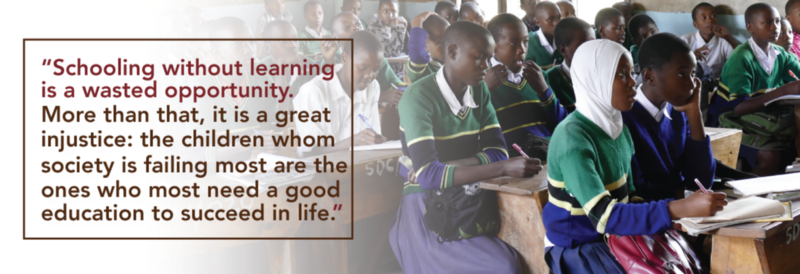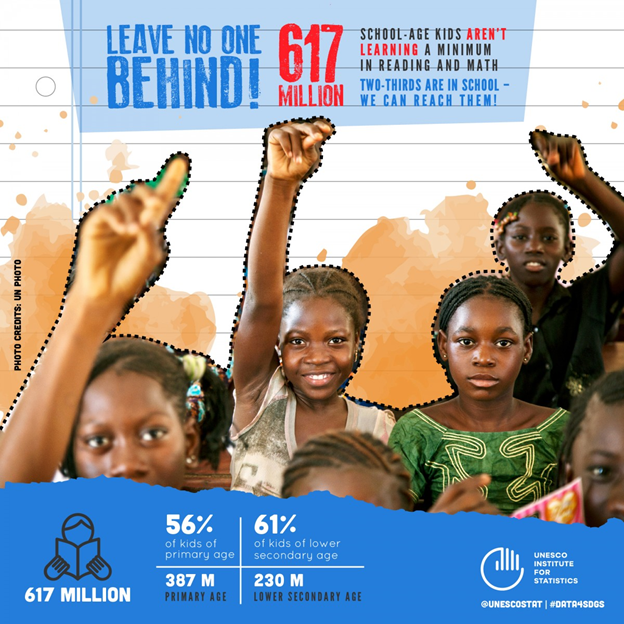
UNESCO Institute for Statistics (UIS) recently completed a study — its conclusion — “The learning situation is dire.” Globally, a significant number of children, six out of ten, and that includes adolescents, are not meeting learning minimums in reading and mathematics, the new UIS paper reports. This new data is the first to be gathered to track the progress of SDG Target 4.1, which requires that primary and secondary education leads to relevant and effective learning outcomes. And we have a long way to go.

Of all regions, Sub-Saharan Africa has the highest rates of education exclusion
Globally, almost 60% of youth between the ages of about 15 and 17 are not in school at all. In Sub Saharan Africa, this number rises considerably. One-fifth of children between the ages of about 6 and 11 and one-third of youth between the ages of about 12 and 14, are out of school. Clearly urgent action is needed, without which the situation is highly likely to deteriorate, especially with the rising demand for education in the face of a still-growing school-age population. The root of the problem can be traced to:
1) Lack of access, with children who are out of school having little or no chance to reach a minimum proficiency level.
2) A failure to retain every child in school and keeping them on track.
3) If they are in school, they are not learning. The issue of quality education, and what is happening within the classroom itself.

Gender bias is a problem “hidden in plain sight”
UNESCO says,“resources within the classroom represent a hidden obstacle to achieving gender equality.” Sexist attitudes are so widespread that even textbooks end up undermining the education of girls, and limiting their career and life expectations.
Girls’ education is a major priority
Even though tremendous steps forward have been made over the past 20 years, the progress however is slow. Girls face disadvantage and discrimination on a daily basis, and are more likely than boys to never set foot in a classroom. Even after we pass the barrier of sending the girls to school, we face the bigger challenge of keeping them in school. Early pregnancy, menstruation, domestic violence, and poor sanitary conditions in school, have joined child marriage as key issues that kept girls firmly at home. The girls disadvantage starts early: 23% of girls are out of primary school compared to 19% of boys and by the time they become adolescents, the exclusion rate for girls is as high as 36% compared to 32% for boys.
The UIS, in addressing the problem of poor learning outcomes, helps governments, donors and civil society groups strive towards Sustainable Development Goal 4 (SDG 4) and reach the most marginalized children. It includes interventions such as access to separate toilets for girls and boys and the presence of female teachers, who in turn serve as role models and encourage girls to continue their education.
Erna Grasz, CEO, Asante Africa Foundation says, “The solution to challenges that girls face lies in the hands of all stakeholders. And while as a non profit we are doing our part, the government must create systems and policies we all can work within. Complex situations like these require a systematic solution. We need to tackle this together. And the first step for this is to make education a priority.” After attending the 72nd United Nations General Assembly, where the Presidents of Malawi, Uganda and Zambia talked passionately about the need to end child marriage in Africa and renewed their commitment to achieving the Sustainable Development Goals, Erna Grasz wrote an open letter appealing to the Presidents of Kenya and Tanzania to join their fight. [View the letter here]
At Asante Africa Foundation, our efforts in education have always included the girls, and in 2011, we launched the Girls’ Advancement Program as a response. We chose to call it Wezesha Vijana (Swahili for “Empower Ourselves”), a fitting title for the curriculum that included teaching girls about their own bodies, building confidence, and imparting practical skills like handling finances.
A learning crisis and no time to waste
This new data validates a “learning” crisis that threatens development around the world. The challenge is to ensure that every child in that classroom is learning. Delivering an education to every child is the civil rights struggle of our time.
Together we must join the call to act now
Gordon Brown, UN Special Convoy for Global Education says, “As a global community we can change these statistics and we must. The time to act is now otherwise we risk leaving half a generation without the skills they need to become employed and participate as contributing members of society by 2030.”
The Swahili phrase “tuko pamoja” meaning we are all in this together, exemplifies this spirit. It requires all stakeholders to develop and facilitate necessary innovation, new learning methods, reformed teaching practices, and internationally financing the development goals. Not only is education a necessary right and a moral obligation, it makes good economic sense. We are striving to create a culture of self reliance and independence in our children. Join us as we link classroom learning to livelihoods outside the classroom, enabling children living in rural communities to have comparable opportunity to their urban counterparts, and allow the girls to have a chance to pursue their dreams just like their brothers.
Across the world, empowered girls are raising their voices to fight for their rights. Join us in giving them the opportunity to become positive catalysts in their communities.
Resources:
Statistical Content provided By Silvia Montoya, Director of the UNESCO Institute for Statistics (UIS)
